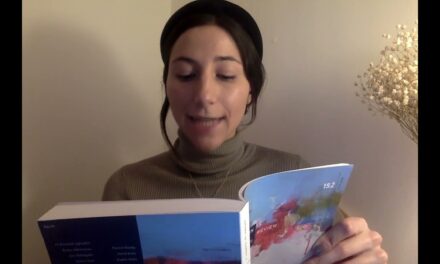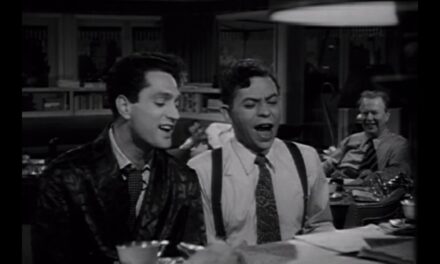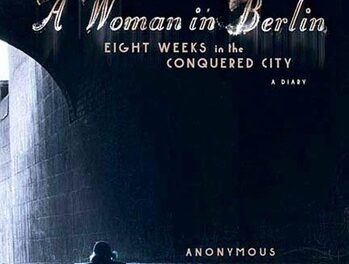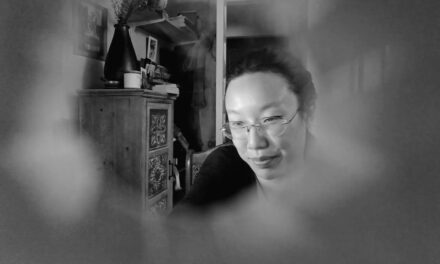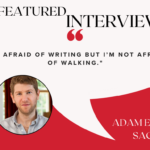Christa Romanosky and Jennifer Murvin are having a literary party, and you’re invited. Sit down with a glass of wine or beer or ginger ale (just drink something, even if it’s morning) and listen in on the conversation in another edition of Pas de Deux, a two-part exchange between contributors. This time, Romanosky is slinging the questions and Murvin dishing up the answers on the latter’s lyrical essay “How to Put Your Child to Bed,” which appears in CR 10.2. The discussion runs the gamut, from use of the second person, process, warm literary hugs, and unspeakable truth.
Christa Romanosky: Your nonfiction piece “How to Put Your Child to Bed” is poignant, compelling, and carefully crafted. I hear the echoes of a children’s book in the repeating “One night . . .” You also juxtapose fantasies of an artist-lover with the ever-changing imagined appearance of the stripper. How did the idea to create this particular piece begin, and what was your writing process like?
Jennifer Murvin: Mary Gaitskill compares why she writes to why “children like to draw pictures of houses, animals, and Mom; it’s an affirmation of their presence in the corporeal world.” The distance of the years between what happened with my husband and the stripper and my discovery of it, the way this distance and the almost comical melodrama of the narrative made it seem like a story instead of fact, compelled me to write if only to affirm its presence in our history—this had happened, to him, to her, to me.
While I was writing, the use of repetition and refrain gave me comfort and structure, much like the real-life act of putting my son to bed. The refrain came to represent the physical routine of motherhood, against which I could meditate on how this discovery had begun to take on a sort of kaleidoscopic significance. Over several months and several revisions, I was able to recognize a connection between what had before seemed disconnected: bedtime, miscarriages, sexuality, age and illness, infidelity, and also literature, its function to make meaning from chaos. The objective restraints allowed me to order and contain wild emotion in a manageable space.
CR: Someone writing in the second-person pov always risks alienating the reader, yet your piece seems to do the opposite. It draws the reader in like an invitation to a private party. (I was thrilled to have been invited, because it was fucking awesome.) Tell me about your decision as a nonfiction writer to craft this piece in second person instead of the more common first person.
JM: We need a lot of wine at this party, ha! I recently heard a craft talk by the wonderful Pam Houston, a master of second person, in which she argued that the second person point of view “creates a thin layer of shame over the narrator and deflects tension from the things he/she is ashamed of. ‘I’ is afraid to say ‘I’ and so says ‘You.’” When Pam said that, I thought, Damn. That is exactly why I had to write “How to Put Your Child to Bed” in second person.
I was certainly ashamed of what had happened and also how I was reacting or not reacting to it. The point of view provided the distance I needed to be honest and vulnerable, to take the emotional risk of fully imagining the stripper, of imagining being her myself. Writing the essay in second person helped me to access myself as a character. This was the first piece of nonfiction I had ever written seriously, toward the goal of publication.
CR: I’m interested in how writing nonfiction affects you. Did you emerge from “How to Put Your Child to Bed” knowing more about yourself, your goals and intentions as a writer, your role as a mother or partner?
JM: I’m interested in how writing nonfiction affects me, too! I am still very new to this genre as a reader and writer. What I do know is that it is deeply satisfying to have something tangible, something “made,” from these difficult moments in my life. I tried to touch on this in the essay itself, this question of how art and life intersect, how readers and writers negotiate that space. I continued to work on this essay as I went through a separation and divorce, and I also changed my MFA emphasis from fiction to nonfiction. I have more questions than answers. Writing a lived experience must change it in the mind; when I think of this time in my life, I often think of the lines I wrote and rewrote in the essay.
CR: What was your timeline in writing this piece? Did you face any unanticipated challenges?
JM: I wrote the first draft in June 2011 and put it away for several months. I picked it up again in the spring of 2012 during the separation and divorce from my husband, and I shared it with a close editor friend that summer and my MFA advisor in November, who was kind enough to let me submit it along with my fiction. The emotional challenge was to keep writing through the changes in my life, and the artistic challenge was to create a cohesive thread between all the disparate elements in the essay. I received a few personal rejections from other magazines before the piece was accepted by Cincinnati Review. The acceptance felt like a warm hug after a very long and lonely journey. A kind of closure not just for the writing of the essay, but for all that had happened, too.
CR: I noticed the speaker in your essay presents alternate versions of the same story, of what is told to different people and what actually happened. For example, when the son asks his mother to tell the story of his birth, he receives a version of this tale. Then the reader receives a more complex explanation of events leading up to the birth. Can you talk about how versions of truth shape the speaker?
JM: This question makes me think of Tim O’Brien and his discussion of story-truth and happening-truth. We tell stories because the real truth is, in a way, unspeakable. It is lived only. Memory is fallible; objective, verifiable fact is often unavailable and/or falls short. Mimesis in this and so many experiences is impossible. Stories or narratives—series of events, sensory details, specifics—access the necessary complexity and contradiction of life’s happenings. For children, stories often perform the opposite function: simplification. The negotiation of these truths—which story best tells what needs telling to the person needing to be told—seems to me the work of being a mother and also a writer.
CR: Which books were on your nightstand while you were writing your essay?
JM: Whenever something emotionally difficult is going on, I turn to Maeve Binchy, whose novels are to me the literary equivalent of hot chocolate and cinnamon toast. If I could go back in time, I’d place by that girl’s bathtub Light Years by James Salter and The Meadow by James Galvin.
Jennifer Murvin’s essays and stories have appeared The Sun, Mid-American Review, Midwestern Gothic, Bellingham Review, Cincinnati Review, Baltimore Review and Moon City Review. She is a faculty member at Missouri State University, where she teaches Fiction Writing, the Graphic Novel, and Contemporary American Fiction. Jen is currently pursuing her MFA in Fiction at Pacific University in Forest Grove, Oregon.
Christa Romanosky earned her MFA in poetry from the University of Virginia. Her poetry has been featured in Cream City Review, North American Review, Cimarron Review, Colorado Review, Mid-American Review, Kenyon Review Online, and elsewhere. Her fiction has appeared in Kenyon Review Online, Cincinnati Review, Boston Review, and Crazyhorse. She has also completed two albums of music, All Things Left Unsaid and Talk About the Sky, available on Amazon, Pandora and iTunes.



